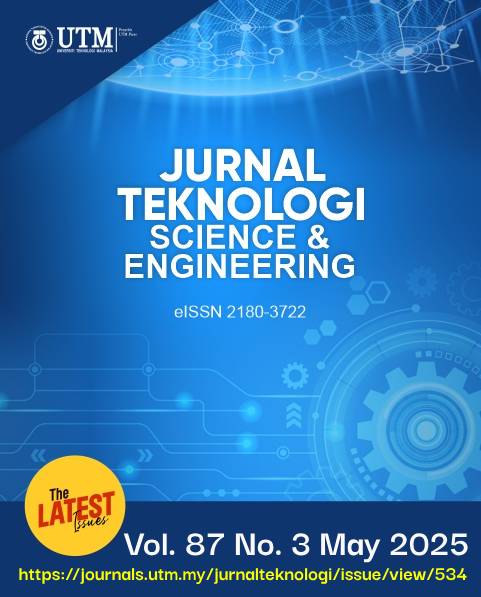LOCATION AND ORIENTATION TRACKING IN AUTONOMOUS SURFACE VEHICLES: REAL WORLD DATA VERSUS DIGITAL TWIN PREDICTIONS
DOI:
https://doi.org/10.11113/jurnalteknologi.v87.22992Keywords:
Digital Twin (DT), Autonomous Surface Vehicle (ASV), Real-Time Data Integration, Predictive ModelingAbstract
The rapid advancement in autonomous technologies has driven the development and deployment of Digital Twins (DT) for various applications, including Autonomous Surface Vehicles (ASVs). This study focuses on creating and implementing a DT for an ASV to enhance environmental monitoring. The DT acts as a virtual replica of the ASV, simulating real-time data and predicting the vehicle's future state. The motivation for this project comes from the increasing need for precise and efficient environmental monitoring solutions while keeping track of the state of the ASV. The primary objective is to develop a DT for an ASV and evaluate its performance in predicting the vehicle's state in scenarios where sensor data is unavailable. The ASV and its DT were deployed in a controlled environment, with various performance metrics, including position and orientation, which are recorded and analyzed to assess the DT's predictive accuracy. When the DT received frequent updates, the mean absolute errors were relatively low: 1.411 meters for distance, 0.708 degrees for roll, 1.812 degrees for pitch, and 18.754 degrees for yaw. Extending the intervals between updates significantly affected prediction accuracy, with the MAE increased by 0.78% for roll, decreased by 21.42% for pitch, increased by 40.18% for yaw, and most significantly, the distance MAE was increased by 89.23%. The results of the study indicated that critical importance of advanced data fusion techniques and real-time processing capabilities from various sensors as well as control systems in real-time to maintain the reliability of the DT.
References
E. Zereik, M. Bibuli, N. Mišković, P. Ridao, and A. Pascoal. 2018. Challenges and Future Trends in Marine Robotics. Annual Reviews in Control. 46: 350–368. Doi: 10.1016/j.arcontrol.2018.10.002.
G. Ferri, A. Manzi, F. Fornai, F. Ciuchi, and C. Laschi. 2015. The HydroNet ASV, a Small-sized Autonomous Catamaran for Real-time Monitoring of Water Quality: From Design to Missions at Sea. IEEE Journal of Oceanic Engineering. 40(3): 710–726. Doi: 10.1109/joe.2014.2359361.
M. H. Bin Mat Idris, M. Al Azhari Bin Che Kamarudin, M. I. Sahalan, Z. Bin Zainal Abidin, and M. M. Rashid. 2016. Design and Development of an Autonomous Surface Vessel for Inland Water Depth Monitoring. 2016 International Conference on Computer and Communication Engineering (ICCCE). Accessed: Jun. 29, 2024. [Online]. http://dx.doi.org/10.1109/iccce.2016.47
A. Martorell-Torres, E. Guerrero-Font, J. Guerrero-Sastre, and G. Oliver-Codina. 2022. Xiroi II, an Evolved ASV Platform for Marine Multirobot Operations. Sensors. 23(1): 109. Doi: 10.3390/s23010109.
D. T. Wang, W. P. Meurer, T. N. Nguyen, G. W. Shipman, and D. Koenig. 2021. Preservation of Oil Slick Samples on Adsorbent Teflon Fabric: Potential for Deployment Aboard Autonomous Surface Vessels. Marine Pollution Bulletin. 169: 112460. Doi: 10.1016/j.marpolbul.2021.112460.
M. Dun and A. Grinham. 2010. Experimental Evaluation of an Autonomous Surface Vehicle for water quality and Greenhouse Gas Emission Monitoring. 2010 IEEE International Conference on Robotics and Automation. Accessed: Jun. 29, 2024. [Online]. http://dx.doi.org/10.1109/robot.2010.5509187.
A. Odetti et al. 2024. Lake Environmental Data Harvester (LED) for Alpine Lake Monitoring with Autonomous Surface Vehicles (ASVs). Remote Sensing. 16(11): 1998. Doi: 10.3390/rs16111998.
C. Gagnon, A. Roemer, R. Mitchell, S. Hurley, J. Hensel, and X. Mcnulty. 2017. Autonomous Surface Vehicle (Asv). https://repository.library.noaa.gov/view/noaa/46264.
D. F. Carlson et al. 2019. An Affordable and Portable Autonomous Surface Vehicle with Obstacle Avoidance for Coastal Ocean Monitoring. HardwareX. 5: e00059. Doi: 10.1016/j.ohx.2019.e00059.
T. Ren, D. Wang, and Y. Zou. 2023. Autonomous Catamaran Unmanned Surface Vessel Based on GPS And Radar. Accessed: Jun. 29, 2024. [Online]. http://dx.doi.org/10.20944/preprints202305.0998.v1
A. Rasheed, O. San, and T. Kvamsdal. 2020. Digital Twin: Values, Challenges and Enablers from a Modeling Perspective. IEEE Access. 8: 21980–22012. Doi: 10.1109/access.2020.2970143.
L. Wright and S. Davidson. 2020. How to Tell the Difference between a Model and a Digital Twin. Advanced Modeling and Simulation in Engineering Sciences. 7(1). Doi: 10.1186/s40323-020-00147-4.
P. Wei, C. Li, Z. Jiang, and D. Wang. 2024. Real-Time Digital Twin of Ship Structure Deformation Field Based on the Inverse Finite Element Method. Journal of Marine Science and Engineering. 12(2): 257. Doi: 10.3390/jmse12020257.
F. Perabo, D. Park, M. K. Zadeh, O. Smogeli, and L. Jamt. 2020. Digital Twin Modelling of Ship Power and Propulsion Systems: Application of the Open Simulation Platform (OSP). 2020 IEEE 29th International Symposium on Industrial Electronics (ISIE). Accessed: Jun. 30, 2024. [Online]. http://dx.doi.org/10.1109/isie45063.2020.9152218.
P. Major, G. Li, H. Zhang, and H. P. Hildre. 2021. Real-Time Digital Twin of Research Vessel for Remote Monitoring. ECMS 2021 Proceedings edited by Khalid Al-Begain, Mauro Iacono, Lelio Campanile, Andrzej Bargiela. Accessed: Jun. 29, 2024. [Online]. http://dx.doi.org/10.7148/2021-0159.
M. Raza, H. Prokopova, S. Huseynzade, S. Azimi, and S. Lafond. 2022. Towards Integrated Digital-Twins: An Application Framework for Autonomous Maritime Surface Vessel Development. Journal of Marine Science and Engineering. 10(10): 1469. Doi: 10.3390/jmse10101469.
A. Hasan, A. Widyotriatmo, E. Fagerhaug, and O. Osen. 2023. Predictive Digital Twins for Autonomous Surface Vessels. Ocean Engineering. 288: 116046. Doi: 10.1016/j.oceaneng.2023.116046.
J.-H. Lee, Y.-S. Nam, Y. Kim, Y. Liu, J. Lee, and H. Yang. 2022. Real-time Digital Twin for Ship Operation in Waves. Ocean Engineering. 266: 112867.
Doi: 10.1016/j.oceaneng.2022.112867.
Junxun Luo. 2024. Simulate Navigation Algorithms of An ASV (https://github.com/MartinJXLuo/Simulate-Navigation-Algorithms-of-An-Autonomous-Surface-Vessel-ASV-/releases/tag/v1.0.0), GitHub. Retrieved June 29, 2024.
Menchon, M. E. A. 2023. Design and Fabrication of an Unmanned Surface Vehicle (USV) for Malaysian Sea. Undergraduate Final Year Project Report. Faculty of Mechanical Engineering, Universiti Teknologi Malaysia.
L. Zhang, S. Li, X. Wu, and Y. Chen. 2021.Gyro Denoising and Fusion Quaternion Attitude Estimation Based on Advanced Filtering Techniques. IEEE Sensors Journal. 20(5): 2571–2579. Doi: 10.1109/JSEN.2020.2994177.
Downloads
Published
Issue
Section
License
Copyright of articles that appear in Jurnal Teknologi belongs exclusively to Penerbit Universiti Teknologi Malaysia (Penerbit UTM Press). This copyright covers the rights to reproduce the article, including reprints, electronic reproductions, or any other reproductions of similar nature.
















